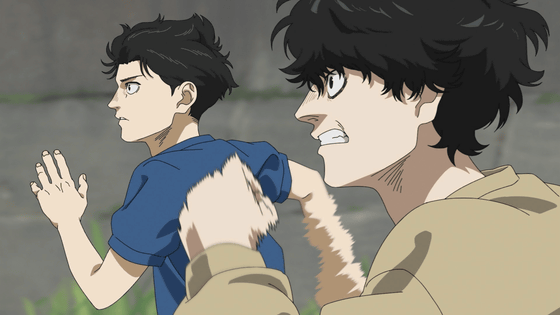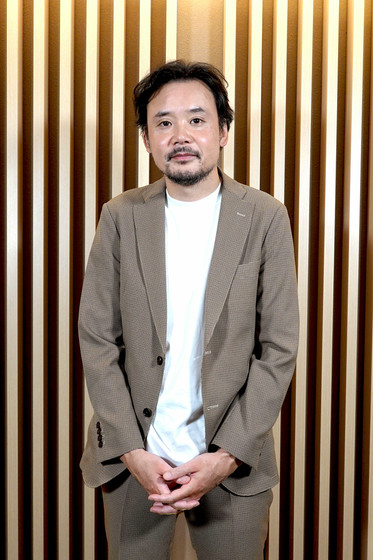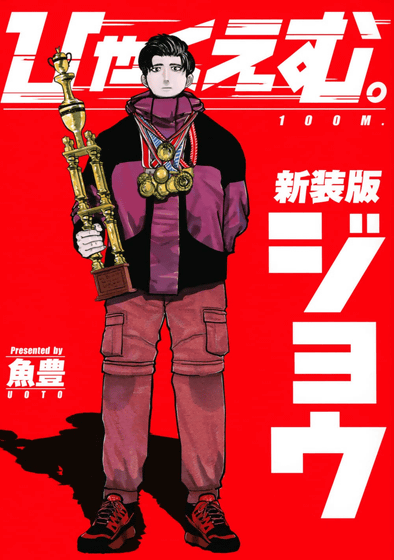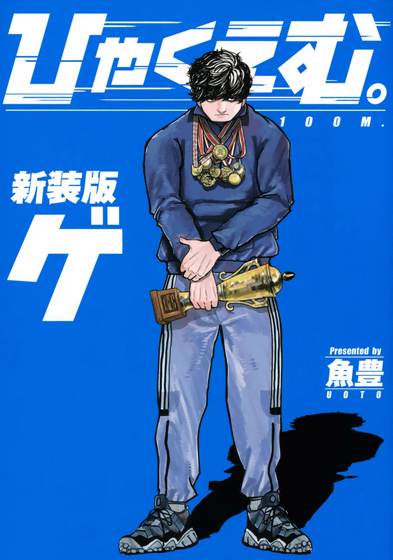An interview with director Kenji Iwaizawa of the animated film '100M.' - what is the method he used to create a richer animation?

The animated film ' Hyakuem, ' which depicts the passion and madness of people captivated by the 100m, a particularly short distance in track and field, is set to be released on Friday, September 19, 2025. Based on the serialized debut work by up-and-coming artist Ushiro Toyo, who became the youngest person ever to win the Tezuka Osamu Cultural Award Manga Grand Prize for '
'Hyakuem.' Official website | Nationwide release on Friday, September 19th
https://hyakuemu-anime.com/
Director Iwaizawa Kenji answered the interview questions.

GIGAZINE (hereinafter referred to as G):
This film is an incredible piece in both visuals and sound, with many vivid sounds I've never heard before. Was a lot of attention paid to the sound?
Director Kenji Iwaizawa (hereinafter referred to as Iwaizawa):
The biggest difference between watching a movie in a cinema and at home is the sound, so we were particular about making the acoustics special.
G:
The sound effects and use of music are very impressive and memorable, but how did the director give you instructions on how to have the music created?
Iwaisawa:
I simply asked Tsutsumi Hiroaki, who was in charge of the soundtrack, to create the main theme, the song I wanted people to hear first to get to know the work. It was a very general request, something catchy and memorable, but in addition to the song that was ultimately used as the main theme, he created four or five other songs as candidates, and I think we were able to create a pretty extravagant piece, as some of the candidate songs were also used in other scenes.
Theatrical animation 'Hyakuem.' Original soundtrack - All songs preview video [Released 9.17] - YouTube
G:
Official X mentioned that 'We paid particular attention to the sound, such as the sound of running with spikes.' The sound is certainly very realistic and immersive, but was this 'running sound' recorded when the original footage for the rotoscope was shot? Or was it recorded separately?
➠➠➠Experience the realistic sounds of land and field!!
— Anime movie 'Hyakuemu.' Official [𝟗.𝟏𝟗(𝐅𝐫𝐢) Release] (@hyakuemu_anime) September 11, 2025
/
Theatrical animation ' #100M .'
Introducing 7.1ch screening theaters🏃
\
This work also pays attention to the sound, including the sound of running with spikes 📽️
Come experience the excitement and realism of being at a stadium at a theater near you!
Theater page: https://t.co/50J8HKuaQL …
Iwaisawa:
When we were shooting the rotoscope, we had a sound recordist come in, and we also recorded just the sound. I wasn't always able to be there for the sound recordings, but as a team we were very particular about the sound.
Producer Yusuke Terada (hereinafter referred to as Terada):
The overall image of the anime was created based on rotoscoped live-action footage, and when it came time to add the sound, the sound team went back to record sounds that matched the images.
Iwaisawa:
Rotoscoping involves drawing pictures based on live-action footage, but the filming was done in a fairly independent way, with some scenes even featuring me running around with the camera.
G:
In addition to rotoscoping, 3D was also used in some parts. What were some of the elements?
Iwaisawa:
We created 3D models based on the running of actual players and drew the characters' running. In particular, the scenes of amateur matches use 3D models rather than rotoscoping, so we created 3D angles from the storyboard and had them add the characteristics of actual players. I think that the process of production is similar to that of regular animation, in that we don't just decide on the angles in the storyboard, but also explore if there are angles we want that are a little more like this.
G:
I see. According to 'Monthly Track and Field,' Producer Terada has experience in track and field, and he said, 'If the scenes where you can see the running aren't realistic, the movie won't be convincing.' Were there any areas where Director Iwaizawa sensed Producer Terada's attention to detail?
'100m x Gekkuri' Togashi's form model, Masashi Eriguchi, says, 'The film realistically portrays how I approach the 100m.' | Gekkuri Online | Monthly Track and Field
https://www.rikujyokyogi.co.jp/archives/181612
Iwaisawa:
I have no experience in track and field, and I didn't have many opportunities to watch track and field events until I started working on this film. This time, when I heard about it from Mr. Terada, I listened to what he had to say and confirmed things about the realism of the track and field scenes as I made the film.
Terada:
I also wanted to hear from an expert about the reality of track and field, so I started by contacting Monthly Track and Field through their inquiry form and asking, 'I'm this guy. Could you please talk to me about it?'
G:
What?
Terada:
Tsuki Riku connected me with the Japan Association of Athletics Federations and various athletes. From around 2022, I also went to watch matches with the coach.
Iwaisawa:
I went to see student matches and the Japan Championships.
G:
Indeed, these legendary athletes are in charge of the form models for each character in this work. Togashi is played by Eriguchi Masashi, who won the men's 100m at the Japan Championships four times in a row and placed fourth in the 4x100m relay at the London Olympics. Komiya is played by Yamamoto Takuma, who represented Japan in the men's 400m relay at the World Relays, and Kaido is played by Asahara Nobuharu, a silver medalist in the 4x100m relay at the Beijing Olympics. This is an impressive lineup of athletes, but how were they chosen?
Terada:
The first people who came to mind with an image of the form were Eriguchi-san for Togashi and Asahara-san for Kaido, so I asked them to do it first, and for the other characters I thought of players who would fit the image, and then I proposed those ideas to Director Iwaizawa and we made the decisions.
G:
Did you have an intuitive feeling that this was the one for you?
Iwaisawa:
My first impression after actually watching the competition was, before I even noticed the form, that everyone was so fast!
G:
I see (lol)
Iwaisawa:
Anyway, they were all incredibly fast, and at first glance I couldn't tell the difference in their form, so when I received information that 'this player's form has these characteristics,' and looked at them in that way consciously, I realized, 'Oh, I see, this is what's different.'
Terada:
We watched footage of various players' matches.
G:
Eriguchi reportedly took photos from various angles and recorded the sounds of the car running in September 2024 and February 2025.
Terada:
That's right. For this shoot, we did additional rotoscoping and recorded sound as well. For Eriguchi-san's shoot, we fixed the start with multiple cameras and then handed the footage over to Iwaizawa-san.
G:
So that powerful opening scene is born from the accumulation of footage like this. Just the other day, a special roundtable video was released featuring Tori Matsuzaka, Shota Sometani, Koki Uchiyama, Kenjiro Tsuda, and original author Yutaka Uo. In it, Yutaka Uo commented on the film, saying, 'Because the running is done using rotoscoping, it's very realistic, and I was able to see a lot of ambiguous aspects that are difficult to express in manga, like being tired or not being able to stop suddenly due to inertia, so it was really good.' Director Iwaizawa, while actually making the film, was there anything that made you feel, 'This is something that can only be done in animation'?
Special roundtable video to commemorate the release of the animated film 'Hyakuem.' [Released 9.19 (Fri)] - YouTube
Iwaisawa:
There are some parts where I think, 'I don't think this movement could have been achieved without rotoscoping,' and it's a rather unimpressive scene, but I think the sequence of 'taking the microphone while speaking' in Zaitsu's lecture scene would be something that wouldn't have happened without rotoscoping. Movement in manga and anime is inevitably symbolic, and even minimal movement can be enough to create a valid expression, but I personally think it's 'richer' when movement is added that doesn't require it. I think you can express anything in animation if you put your mind to it. I think the fun of animation is probably the accumulation of these kinds of things. There are many parts like that in Studio Ghibli's works, and I think that's why everyone is familiar with them.
G:
Director Iwaizawa is said to be an avid fan of Studio Ghibli films, and this is one of the reasons why.
Iwaisawa:
I originally started out with live-action films, so I'm particular about realism. I like animations with realistic movements that are quite close to reality, as is the case with '100M.' I'm drawn to animations with unnecessary movements that normally don't need to be expressed, or movements that make the animation richer, and I want to incorporate them myself. There are limits to what the human mind can think, after all, and I think that with rotoscoping, there are parts that are brought out by the actors' performances.
G:
I see. The story of '100M' begins when Togashi and Komiya were in elementary school, but what kind of elementary school were you, Director Iwaizawa? Just like Togashi always did track and field, did you love movies from an early age?
Iwaisawa:
I liked drawing, so I vaguely thought, 'I want to be a manga artist.' I was pretty good at sports, but I don't have any interesting stories to share.
Terada:
You were a baseball player, right?
Iwaisawa:
Ah, that's right. I played baseball in high school. However, it wasn't a particularly strong school, so I just 'played it for a while.' If there was one thing that was a little unusual about me, it was that I used to commute to school by bicycle, which took an hour each way.
G:
That's quite far away...
Iwaisawa:
In 'Hyakuem.', Komiya commutes to school by bicycle, which takes two hours, so I think there are some similarities (laughs).
G:
(lol)
Iwaisawa:
He played baseball, but he also wanted to be a manga artist, so he would stop by a second-hand bookstore on his way home to buy manga and read them when he got home. At first he read Weekly Shonen Jump, but gradually he started reading works by Katsuhiro Otomo, and then he shifted more to young men's magazines, and as he started to see manga influenced by movies, he gradually became interested in movies as well.
G:
Speaking of creative process, you mentioned in an interview with CINEMORE that you spent seven years making 'Ongaku,' which was released in 2020, and that you spent 80% of that time on production, with the remaining 20% coming from part-time jobs or dipping into your savings. Were there any changes to your production structure for this film?
'Music' Director Kenji Iwaizawa: What already exists in live-action becomes something completely new the moment it becomes animated [Director's Interview Vol. 98] | CINEMORE
https://cinemore.jp/jp/news-feature/1768/article_p1.html
Iwaisawa:
For this film, I had to get help from many people to meet the deadline, and I also had the participation of people with professional skills. However, I have an independent production style, and even when shooting with rotoscoping, my production method doesn't change much regardless of the budget. For example, there is a 3 minute 40 second one-take scene in the film, which would never be possible in a normal commercial production, and it's not something that can be done just because you have a budget; it's a production method that can only be done in my own style. In the end, when I'm a director, I have to stick to my own way, regardless of the budget, and that's what I realized while making '100M.'
G:
The 3 minute 40 second single shot is from a national high school tournament, where the players come out one by one before the match.
Iwaisawa:
that's right.
G:
During the roundtable discussion, Uo Toyo said, 'I heard that that scene took a year to draw, with many people taking turns, and the director started it first and then drew it again at the end, but it seems that he drew it from August of last year until this month (August 2025).' What parts did the director draw?
Iwaisawa:
Like the trees in the background.
G:
Why did you decide to have the director portray it?
Iwaisawa:
That's because only you can draw it.
G:
What!?
Iwaisawa:
If you ask someone to draw something for you, they might be able to draw one or two pictures, but it would be impossible to draw dozens or hundreds of pictures.
G:
So the reason was that simple... The majority of the background art in this film was created analoguely, with art director Yamaguchi Keikanka commenting, 'In one scene from when the characters were in elementary school, we drew 29 pieces of background art for a three-second cut. It's a lot of work, but we're trying to find a unique way to express the work in our own way.' What effect were you aiming for by drawing by analogue?
◢◤ ̄ #Until the 100M finish
— Anime movie 'Hyakuemu.' Official [𝟗.𝟏𝟗(𝐅𝐫𝐢) Release] (@hyakuemu_anime) August 19, 2025
⠀ And 𝟓𝟎𝐦 _◢◤
⠀
The background art of this work is
To express the depth of hand-drawn art, most of the film is analog.
⠀
By creating a worldview, we will get closer to completion step by step.
⠀
Art director #Yamaguchi Keikan's comment 📨… pic.twitter.com/x0iG98p1Xh
Iwaisawa:
I'm an analog person, and although I do use digital to some extent, when I draw it myself, it becomes analog. Also, as digitalization progresses and AI comes on the scene, the warmth of human hands is starting to disappear in works, so I thought that creating background art analogically would be an expression that gives a special added value to a work. Things that were commonplace in the past are no longer commonplace. When I thought about how to differentiate this work from other works within the current production method, I thought that using analog was one key point, and there were some aspects that I was particular about.
G:
Perhaps it's related to your commitment to analog, but I saw a stage greeting where Director Iwaizawa said that when he first started making animation for 'Fukuraicho, Tunnel Alley Man,' he thought about how to make it and decided to just 'trace live-action footage,' and didn't know that it was a technique called rotoscoping. What made you want to make animation in the first place?
Man in the Tunnel Alley, Fukuraicho - YouTube
Director Kenji Iwaizawa appears on stage! [Director Kenji Iwaizawa Special] Stage Greeting REPORT - YouTube
Iwaisawa:
I wanted to be a live-action director, but I didn't find it interesting to make films, so my work never took shape. But when I decided I wanted to make my own film, I've always loved drawing, so I thought that if I traced live-action footage, it would become animation and I could create something a little different. That feeling back then, 'Just give it a try,' hasn't changed at all. Not many people do a single cut of 3 minutes and 40 seconds, but I thought I'd give it a go.
G:
It's a really amazing scene.
Iwaisawa:
For now, I know I can do it if I draw a lot. It's just that the amount is huge.
G:
Well, that's true (laughs).
Iwaisawa:
When it comes to drawing a lot, I don't find it difficult at all.
G:
So you were able to 'give it a try.' Like the tree in the one-shot scene, did you draw quite a lot of different things?
Iwaisawa:
Well, I've pretty much only drawn trees (laughs).
G:
It's almost all wood! Does it feel like the director is in charge of the toughest parts?
Iwaisawa:
I like drawing details like trees and natural objects, and I also like the feel of dirt and rocks.
G:
I thought the trees moved in great detail, but it was because you love the film. That makes sense. The film is scheduled to be released in theaters on Friday, September 19, 2025, and the first screening was held on August 14. What did you think of the finished film, director?
'100M.' is complete!!!
https://t.co/ZbzAONqAbN — Kenji Iwaizawa (@iwaityawa) August 14, 2025
First, I showed it to the people involved who had helped me, but I was nervous the whole time I was watching it.
Thank you very much to everyone who cooperated!!!
Thank you so much!!!
Iwaisawa:
Well... for now I feel like 'I just made it in time' and 'It's finished', but rather than being completely happy and saying 'It's finished!', I feel like there's still something going on.
Terada:
From the first time we met, Director Iwaizawa declared that he wanted to make an entertainment film, and we worked together on '100M' with the aim of creating a film with a content and scale that would meet his expectations. It's a film that I'd like a wide range of people to see, so I hope you'll go see it in the theater.
G:
I see. Thank you for sharing so many interesting stories with us today.
The film '100 M.' is currently a huge hit. On Tuesday, September 30, 2025, Toho Cinemas Hibiya will host a special stage greeting to thank fans for the film's success, featuring Tori Matsuzaka (who plays Togashi), Shota Sometani (who plays Komiya), and director Kenji Iwaizawa.
A stage greeting to thank fans for the huge success of '100M.' will be held on Tuesday, September 30th! | Official website for the film '100M.' | Nationwide release on Friday, September 19th
https://hyakuemu-anime.com/event/592/
In addition, limited-edition attendee gifts will be available until Thursday, September 25th, with the first wave featuring original illustrations by Uo Toyo, the author of the manga, featuring Togashi and Komiya. From Friday, September 26th, the second wave will feature Zaitsu and Kaido.
Gifts to moviegoers will be distributed for two consecutive weeks! | Official website for the film '100M.' | Nationwide release on Friday, September 19th
https://hyakuemu-anime.com/info/252/
The first six minutes of the story look like this:
Theatrical animation 'Hyakuem.' 6-minute opening footage specially released! [Now showing as a huge hit] - YouTube
©魚豊・講談社/『ひゃくえむ。』製作委員会
By the way, the original work is complete, and the new edition is composed of two volumes.
100 M. New Edition (Vol. 1) (KC Deluxe) | Uo Toyo | Books | Online Shopping | Amazon


Related Posts:







